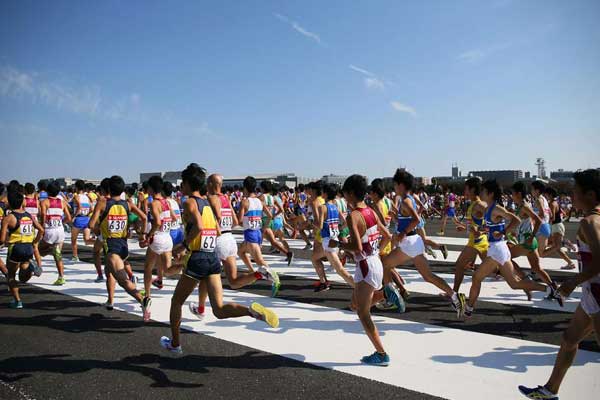The Japan Association of Athletics Federations (JAAF) has embarked a program to eradicate the misuse of the improper use of Iron Injections-considered an effective anti-anemia measure for teenager in the long-distance running world-because of the negative side effects due to excess intake on users health.
“The excessive use of iron injections is problematic from the standpoint of both health and ethics,” JAAF senior managing director Mitsugu Ogata said at a JAAF board meeting on Dec. 17.
Just days later, the JAAF held a consultative meeting in Tokyo on Dec. 20 regarding iron injections for the first time, with the participation of junior high school, high school, university and corporate organizations. The association decided that by spring, it would establish guidelines banning the use of iron injections, with the exception of those that doctors determine are necessary. Iron shots requested by coaches, athletes, or athletes parents would be prohibited.
“It’s possible that there were doctors out there who gave athletes iron injections at the request of coaches without running any blood tests,” Fumihiro Yamasawa, a physician and head of the JAAF’s medical affairs committee said at the meeting.
The body is able to function because oxygen travels to every inch of it through blood. Hemoglobin in the red blood cells is what carries the oxygen, and decreased hemoglobin levels cause anemia. The demand for iron, which is vital in creating hemoglobin, increases during growth spurts. Long-distance runners are more likely than others to develop hemolytic anemia, caused by the shock of the back of their feet hitting the ground, thereby destroying red blood cells.
According to JAAF’s medical affairs committee, the amount of iron that runners are said to need a day is 15 to 18 milligrams, which can be ingested through a diet of 2,500 to 3,000 calories per day. However, because long-distance runners are believed to be at an advantage when they are at a low body weight, some coaches demand that runners limit their food intake in addition to undergoing intense training. Anemia prevention is crucial in protecting the health of younger athletes.
“A physician calculating iron levels and (administering iron injections) is considered authorized medical treatment, not doping,” explains Naoki Mukai, a University of Tsukuba associate professor who specializes in sports medicine. However, iron shots are reserved for extreme symptoms that require immediate treatment, such as heavy bleeding. In general, iron tablets are used to supplement intake from food to prevent anemia. While these tablets enable limited iron absorption, injections deliver iron directly into the bloodstream, making their effects immediate.
— ‘Shooting nutrition’ to improve endurance, performance
According to people involved in track and field, iron injections came into use in the 1990s. It is said that iron shots improve endurance by improving the reach of oxygen throughout the body even in a state of anemia. A number of people had comments to share in connection with those injections, ranging from “I heard that one could slash one’s record in the 3,000-meter run by 30 seconds,” to “A runner who wasn’t able to run just the other day suddenly began running again.” It turns out there is even a code word for the act of getting iron injections: “shooting nutrition.”
Nippon Sport Science University professor Masaaki Sugita, who offers support to athletes as a sports medicine specialist says, “I suspect the successful experiences that resulted from iron injection use have led to their integration into coaching.” It is easy, however, to overdose on iron through injections, which can lead to impaired function of organs such as the liver and the heart. While the shots may not constitute doping, improving one’s competitive edge through injections that are not for medical purposes undermines fairness of the sport.
— Over half of surveyed university runners had used iron supplements
A survey conducted by JAAF’s medical affairs committee this year on long-distance university runners who compete in national meets and university long-distance road relays showed that over half of both male and female runners had used iron supplementation in the past. Those who said they’d received iron injections — 16.9 percent among female runners and 11 percent of male runners — exceeded estimates of people involved in the issue.
Tomohiro Manabe, a member of the JAAF medical affairs committee and a physician at Keio University’s Sports Medicine Research Center, takes the results of the survey seriously. “It goes to show that improper use (of the injections) has spread,” he says.
The effects of excess iron intake is said to last several years. Normal serum ferritin levels, which reflect the amount of iron stored inside the body, range from 25 to 250 nanograms per milliliter; 500 nanograms per milliliter or more is considered excessive. According to Nippon Sport Science University professor Sugita, one former runner on the Japan national team had serum ferritin levels of nearly 600 nanograms per milliliter at the point they graduated high school and joined a corporate running team. Even though the runner stopped receiving injections, it took two years for their serum ferritin levels to drop below 100 nanograms per milliliter.
— Long term effects of too much iron intake
While the human body needs iron, excessive intake of the mineral can wreak havoc, impairing the function not only of organs, but of the body’s ability to produce hemoglobin. A different female runner who received iron injections during her high school years was unable to set significant records after graduation. Looking back, her coach at the time says, “Her body’s ability to produce iron on its own had been diminished, and she had to catch her breath constantly.” Another coach says there are runners who become disheartened that they can no longer run the way they used to.
JAFF began to feel an acute sense of crisis when the Japan Institute of Sports Sciences (JISS) began conducting blood tests on young athletes several years ago. The average serum ferritin level of high school girls competing in mid- to long-distance events was found to be 79.8 nanograms per milliliter, with some girls measuring over 500 nanograms per milliliter. This figure was twice the average among women across all track and field events, which stood at 37 nanograms per milliliter. JAFF released a flyer on “seven measures against anemia among athletes” in 2016, warning against the dangers of excessive iron intake.
While 21 male runners have secured the right to compete in the Marathon Grand Championship series (MGC), which will be held in September 2019 as qualifiers for the 2020 Tokyo Summer Olympics, only eight female runners have done so. It is not uncommon for top female runners in high school to not do as well as anticipated after their high school years, and thus retire from the sport at a young age. Some JAFF staff involved in training athletes for the national team believe this is due not only to extreme training and food restrictions, but also the effects of iron injections.
There are instances in which corporate teams take active measures to protect the health of their athletes. The Dai-ichi Life Insurance Co. team’s head coach, Yamashita, periodically has the team’s athletes undergo blood tests and bone density tests as part of measures to counter osteoporosis. Because of her long-term vision, many members of Yamashita’s team have gone on to compete in the Olympics and world championships.
“When you interfere with growth during a young athlete’s developing years, it hugely impacts their future,” Yamashita says. “Unless we improve this process, there will be no bright future ahead of us.”
Disclaimer:
The information contained in this article is for educational and informational purposes only and is not intended as a health advice. We would ask you to consult a qualified professional or medical expert to gain additional knowledge before you choose to consume any product or perform any exercise.






